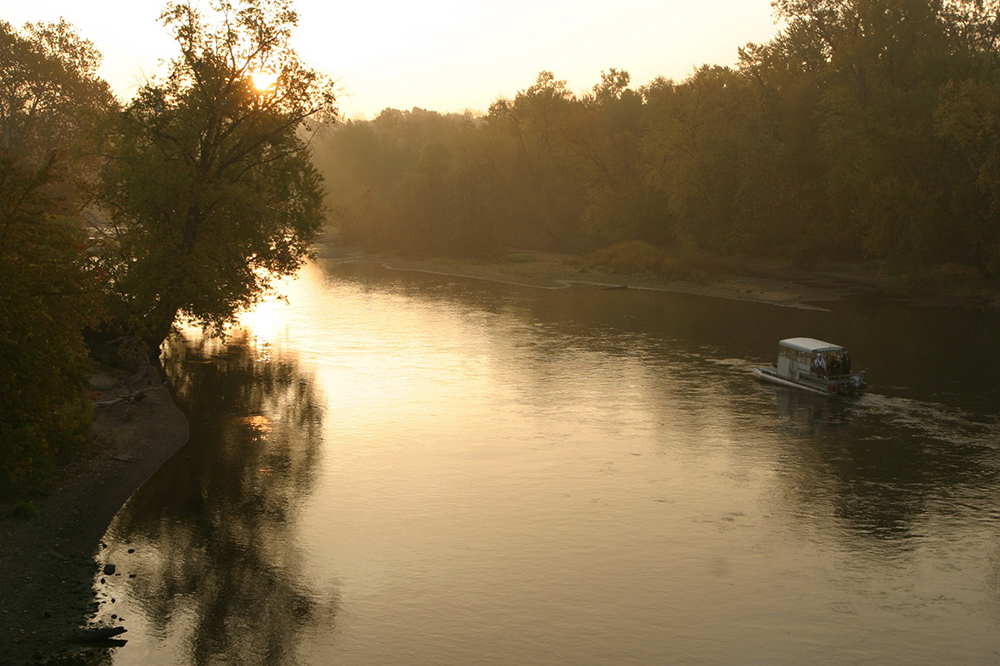Andrews University Recognized for Continued Creation Care Efforts
School named an affiliate member of the Higher Education Climate Leadership Network.
December 10, 2024 | Berrien Springs, Michigan, United States | Andrew Francis, Andrews University News
Andrews University, led by its Creation Care Council, has achieved the distinction of being named an affiliate of the Higher Education Climate Leadership Network and received a national grant for the environmental efforts it currently makes and for its plans to further such environmentalist action.
Founded in 1874, Andrews University is a premier institution of higher education for the Seventh-day Adventist Church. Its main campus is in Berrien Springs, Michigan, United States, but the university also provides instruction at colleges and universities around the world.

The St. Joseph River runs next to the main Andrews University campus in Michigan, United States. [Photo: Gerald Paul New]
The Higher Education Climate Leadership Network is a group created by the nonprofit organization Second Nature, based in the United States, that focuses on helping higher education institutions solve sustainability issues. The recognition of Andrews University provides the Creation Care Council with a national network of resources and opportunities with other universities and colleges across the country in matters relating to environmental stewardship and climate action.
Andrews University is already a member of the Michigan Climate Action Network and is in the process of joining the United Nations Climate Change and Universities Partnerships Programme. These initiatives provide opportunities for underserved students and are funded by Title III grants. NASA notes, “There is unequivocal evidence that Earth is warming at an unprecedented rate. Human activity is the principal cause.… Earth-orbiting satellites and new technologies have helped scientists see the big picture, collecting many different types of information about our planet and its climate all over the world. These data, collected over many years, reveal the signs and patterns of a changing climate.”
Andrews University was also one of 11 schools in the US awarded a 2024 Second Nature Catalyst Grant, which provides US$7,500 to support climate action initiatives. The university’s proposal, written by Padma Tadi Uppala, associate dean for research and creative scholarship in the College of Health & Human Services, professor in the School of Population Health, Nutrition & Wellness, and a member of the Creation Care Council, is to develop a pilot hydroelectric project to generate clean renewable energy for the campus by using the constant water flow of the St. Joseph River.
According to the grant proposal, in addition to providing the university with a cleaner energy source, this hydroelectric project could result in “an estimated annual savings of about US$1,000 per turbine for the university.” This projection is based on an estimated turbine output of 14 kilowatts per hour.
During a recent presentation by Uppala with Taylor and Katherine Koudele, chair of the Department of Sustainable Agriculture and professor of animal science, during the 2024 Andrews Autumn Conference on Religion and Science, several projections were made concerning the hydroelectric project. The university is expected to reduce its carbon emissions by 4,395 pounds annually, and there are hopes that this technology can be shared with neighboring Berrien County communities that are also located alongside the St. Joseph River. In the grant proposal, Uppala also noted that the use of hydroelectric sources is the best renewable energy option for Andrews because its geographic location limits the effectiveness of wind and solar power sources.
Plans are currently being developed for the construction and implementation of the turbine system. Matías Soto, an adjunct faculty member of Andrews’ School of Engineering and the director of the Innovation & Entrepreneurship program, was instrumental in crafting the hydroelectric project. He shared that the university is still waiting “to obtain government permits for design and construction of this project.”
The original version of this story was posted on the Andrews University news site.